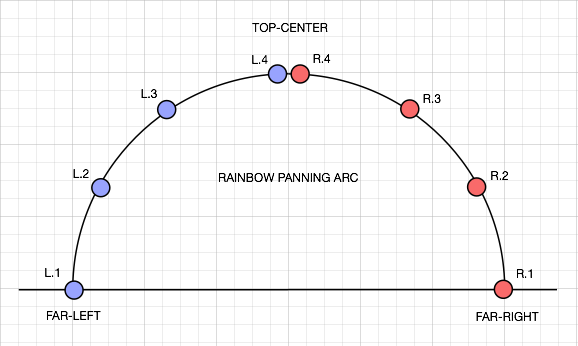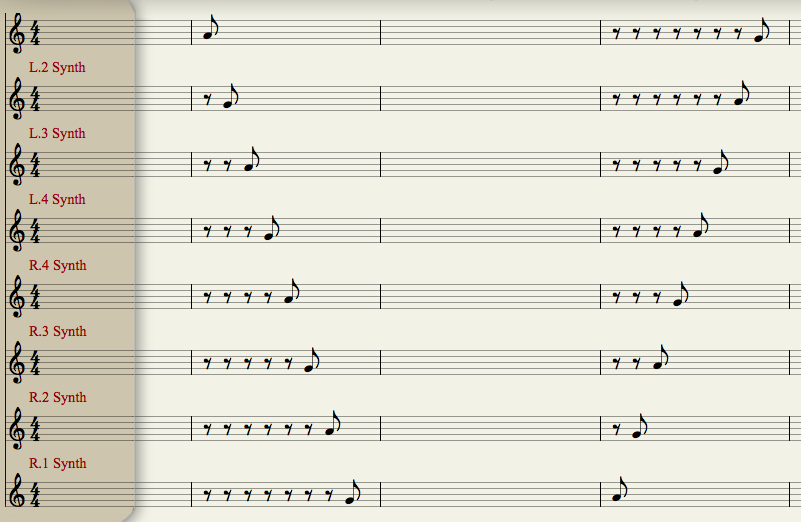[NOTE: The Latin percussion is fully "sparkled", which requires eight (8) staves, where each staff is mapped to a different location on the "rainbow panning arc", so the 1/8th notes of each measure move either from far-left to top-center to far-right or from far-right to top-center to far-left, and the Latin percussion instruments alternate between a shaker and a cowbell as a simple pair or tuplet, where the shaker is played as an "A" and the cowbell is played as a "G" in the music notation, which adds another dimension to the motion and is easiest to hear if you listen with studio quality headphones like the SONY MDR-7506. For reference, {L.1, L.2, L.3, L.4} goes from far-left to top-center, while {R.4, R.3, R.2, R.1} goes from top-center to far-right, which makes sense if you think about it for a while, because there are several things happening, and the idea is to do a mapping of (a) panning location, (b) time, (c) duration, and (d) pitch, although there are other variables, since it is a multidimensional vector space, and there is curl, which I think is the correct mathematical terminology . . . ]

[NOTE: The way this works is that the left side of "V" in the music notation (see below) does a sweep from far-left to top-center to far-right, while the right side of the "V" in the music notation does a sweep from far-right to top-center to far-left, but there are other patterns for the motion along the "rainbow panning arc". One of the stellar features of the NOTION 3 Mixer is that it has true stereo panning controls, which is what makes doing precise placement of individual notes both possible and practical. It requires a bit more music notation, since there need to be eight (8) identical instruments, but no matter how it is done, it takes a bit of work, and the advantages to doing it in NOTION 3 with music notation and the NOTION 3 Mixer are (a) that it is precise, (b) that it allows individual note granularity, and (c) that it is easy to modify, since the notes are played by VSTi virtual instruments and specified in music notation . . . ]

"Tastes Like Anarchy" (The Surf Whammys) -- MP3 (7.5MB, 302-kbps [VBR], approximately 3 minutes and 24 seconds)
Fabulous!
With the newly added eight (8) staves for the fully "sparkled" Latin percussion instruments (shaker and cowbell) the total number of staves is approaching the upper limit for "heavy" VSTi virtual instruments in a single NOTION 3 score, so the next step in the system or "formula" requires switching to doing the mixing and mastering in the Digital Audio Workstation (DAW) application, which here in the sound isolation studio is Digital Performer 7.24 (MOTU), and the NOTION 3 generated audio is recorded as soundbites in Digital Performer 7.24 via ReWire, where Digital Performer 7.24 is the ReWire host controller and NOTION 3 is the ReWire slave . . .
Once the current instruments are recorded as soundbites in Digital Performer 7.24 via ReWire, I save the NOTION 3 score and then clone it via doing a "Save As . . .", where I append "-PT-1" to the filename, followed by cloning it a second time via "Save As . . .", but this time I change "-PT-1" to "-PT-2", so that the "-PT-1" file is the original NOTION 3 score, and the "-PT-2" is the second score, and then the process continues depending on how many instruments are required, where the general rule is 20 to 25 "heavy" VSTi virtual instruments per NOTION 3 score . . .
At present, there are 21 instruments, so I might be able to add four more instruments to bring the total to 25 instruments, which is a convenient number of instruments, since I like to keep five (5) instruments common to all the clones, where the five (5) common instruments are used as reference points for the rhythm, bass, chords, and simple melody, which works nicely, because by the time the number of instruments requires switching to the cloning phase I have listened to the song enough times not to need to hear all the instruments all the time, since (a) I can hear all the instruments in Digital Performer 7.24 and (b) at this point I am adding more specific instrumentation, and while this might appear to be a bit complex, it makes sense to me . . .
If you think about it for a while, the procedures are not so different from building a model airplane or going grocery shopping, at least for typical DISCO and Pop songs, where the key to the strategy is to have a system or "formula", since layering requires having a basic plan, which mostly is a matter of having a well-defined system or "formula", because once you have a handful of instruments working nicely, then adding everything tends to be an iterative process based on listening to what is present for a while and then adding more stuff where it makes sense to add it, which is one of the reasons that I like to use SampleTank 2.5 XL (IK Multimedia) for all the instruments in the original NOTION 3 score, since when I clone the original score all I need to do to change an instrument is click on the name of the staff in the NOTION 3 Mixer and the SampleTank 2.5 XL standalone user interface appears, at which time I change the selected instrument to whatever new instrument I want it to be, which generally avoids having to do a lot of reconfiguring, although sometimes I will replace the VSTi virtual instrument for a staff with (a) another IK Multimedia VSTi virtual instrument (Sonik Synth 2, SampleMoog, SampleTron, or Miroslav Philharmonik), (b) something that uses the Kontakt (Native Instruments) VSTi virtual instrument interface, (c) a NOTION 3 bundled instrument, or (d) yet another VSTi virtual instrument like Twin 2 (FabFilter Software Instruments), which at present are the virtual instruments I am using, which is fabulous . . .
Fabulous!


